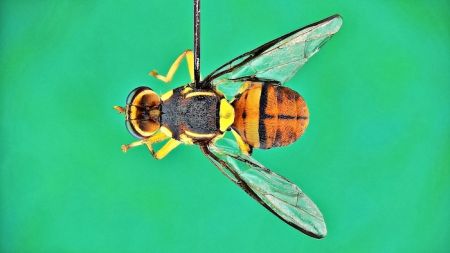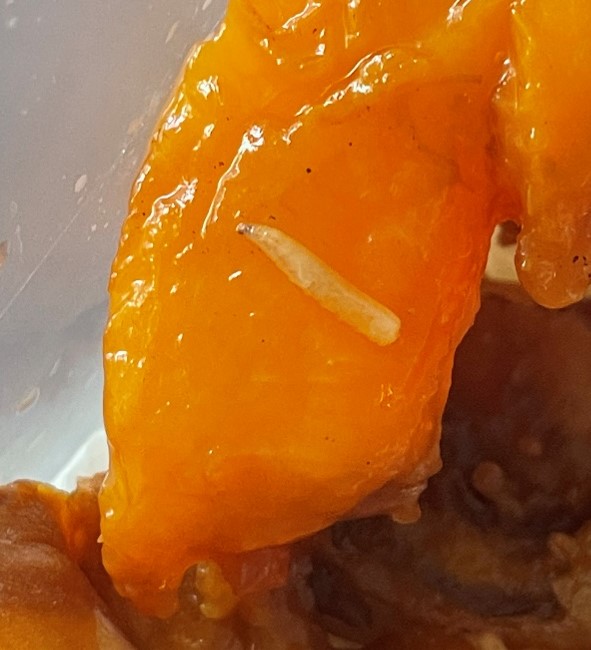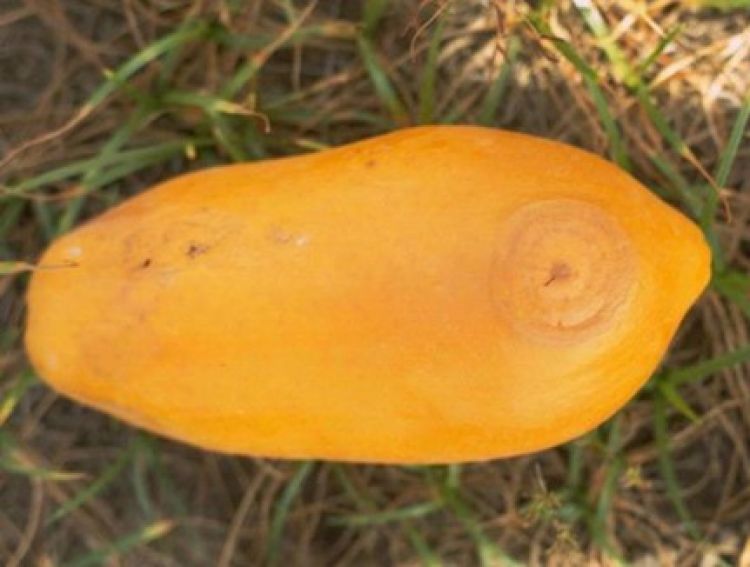Oriental fruit fly
EXOTIC PEST – Not wanted in Australia
Oriental fruit fly (Bactrocera dorsalis) is one of the world’s worst horticultural pests and poses a serious threat to Australia’s fruit and vegetable industries.
Keeping Oriental fruit fly out of the country is a national priority.
Have you seen this pest?
- Adults are about 7mm long with a black back and paler abdomen which has a distinctive T-shaped marking (Fig. 1)
- Females lay eggs under the skin of fruit and vegetables of host plants.
- Creamy white larvae (maggots) up to 10mm long, feed inside fruits and vegetables of host plants (Fig. 2).
- Feeds on over 400 hosts plants, but is commonly found in avocados, mangoes and papayas.

What should I do?
- Report immediately.
- Share your photos with us using the Online Public Reporting Form OR
- Call the Exotic Plant Pest Hotline 1800 084 881.
- Please take good quality photos of the pest and/or damage to include in your report. For tips see the How to take good photos for a report guide.
Why is it a pest of concern?
- Oriental fruit fly is one of the most damaging horticultural pests globally, impacting over 400 varieties of fruits and vegetables.
- Female fruit flies inject eggs into the fruit, and after hatching larvae tunnel through the fruit feeding. Considerable damage can be caused before an infestation is observed, and entire crops can be lost if unprotected. Egg laying sites cause damage to the fruit resulting in decomposition (Fig. 3).
- Oriental fruit fly is not present in Australia but is established in many nations in Asia and Oceania. Thus, the risk of incursions into Australia are high and would result in significant economic impact.
- Eradication of the 1995 Oriental fruit fly incursion in Cairns cost $33 million and took 4 years.


Where to look
- Adults feed on nectar and decaying fruit and will travel to find new egg laying sites.
- Eggs and larvae are found within fruit and pupae in the soil under fruit.
- Unlike most fruit flies, including the local Queensland fruit fly, Oriental fruit fly can also infest immature, green and hard fruit (Fig. 4).

Pest profile
Appearance
- Adults: Small, 6–8 mm in length, and have clear wings with a narrow, brown band extending along the outer margin. The abdomen is yellow to golden-brown with a dark ‘T’ shape marking (Fig. 1).
- Larvae (maggots): Larvae are white and up to 10 mm in length (Fig. 2).
- Pupae: Found in the soil and range in colour from white to brown, are cylindrical in shape and around 5 mm in length.
- Eggs: Eggs are white to yellow, 1 mm long by 0.2 mm wide.
Host plants in Australia
- Oriental fruit fly has been recorded from over 400 varieties of fruit and vegetables, including apricot, avocado, banana, citrus, fig, guava, loquat, mango, papaya, passionfruit, peach, pear, persimmons, pineapple, and tomato.
- The wide host range of the species means that it may occur on a considerable number of native plant species as well.
Life cycle
- The life cycle from egg to adult takes as little as 14 days in warm weather (30ºC) but extends as the weather gets colder, up to 40 days at around 15ºC.
- Mature larvae leave the fruit and dig down into the soil to pupate. The adult fly emerges from the puparium after a week to a month depending on the temperature.
- Female adults start laying eggs between 2-6 weeks after emergence depending on conditions.
- Adults typically live 1-2 months and can remain overwintering in citrus tree canopies in the colder months. There are multiple overlapping generations per year.
Distribution and dispersal
- Native to southeast Asia, Oriental fruit fly has spread throughout Asia and is also present in Africa, the Americas and Oceania including Christmas Island, Papua New Guinea, Palau, Tahiti and Hawaii.
- Adult flight results in dispersal but previous citations of long distances (50-100 km) are unsubstantiated. Dispersal of between 2-4 km is more typical.
- Can be dispersed long distances by the prevailing winds common during the Australian northern wet season which is likely to be the cause of transient incursions onto the Torres Strait Islands and/or Far North Queensland most years.
- Illegal importation of infested produce is also a likely source of an incursion.
Prevention
- Monitor imported host plants, fruits and vegetables carefully to prevent the spread of the pest.
Image credits
Fig. 1. Copyright cdhsiao, iNaturalist CC BY-NC 4.0
Fig. 2. Agriculture Victoria
Fig. 3. William M. Brown Jr., Bugwood.org
Fig 4. Copyright Photo Kao, iNaturalist CC BY-NC 4.0 adult
Page last updated: 31 Jan 2025